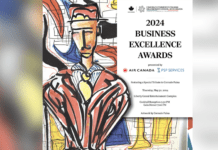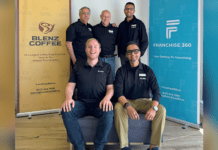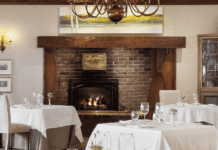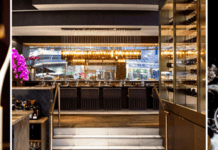A dream kitchen can be many things to many chefs. For some, the delight is found in the latest features and functions that come with the kitchen-appliance basics. For others, the wish list might be something completely different — to expand a menu or provide a showpiece statement for guests.
A dream kitchen isn’t necessarily visible to the naked eye. Much of it is found in the groundbreaking technology working behind the scenes — a fact some say is creating a new dynamic for training the chefs of the future.
“The traditional kitchen that most chefs grew up with is going to be a thing of the past,” says Mark McEwan, executive chef and Alberta Regional Sales Manager for Foodservice Solutions in Calgary. “Technology will be a huge part of that change. Chefs need to embrace technology in this day and age as they face rising labour and food costs.”
McEwan says his company has adopted a smarter-kitchens mandate within the last two years, bringing in products that are cutting edge “and will make a chef’s life easier or better”.
THE BASICS 2.0
When asked to map out his dream kitchen, combi-ovens top McEwan’s list. “They came on the scene 15 or more years ago. Then you thought of it as a steamer and convection oven that allows you to increase yields and improve consistency. The exciting part is how you can interact with them by telling them to do this, that or the other.”
His favourite example is the Wi-Fi-enabled Lainox Naboo, which has an interactive management system that can calculate food costs and caloric intake, scale recipes up and down and create feature menus. “All that technology can enhance the cooking experience for sure. And the interface is the same as a smartphone or tablet, so it’s familiar.”
Another advanced system is the NEO, also from Lainox. It’s a blast chiller and shock freezer that can also be programmed for hot holding, thawing, slow cooking, sous vide and proofing. “Technology that advanced is pretty amazing, if you know how to use it,” McEwan notes. “You truly have to understand how to operate the technology to realize the benefits.”
He also points to rapid-cook ovens as another must have in the dream-kitchen scenario. “Everyone looks at them as the ‘Subway oven’, but now, high-end chefs are incorporating them into their kitchens for appetizers, desserts and entrées because they can cook 15-times faster than a regular oven.”
Michael Bryanton, R&D chef at Holland College’s Canada’s Smartest Kitchen in Charlottetown says the programmability of rapid-cook ovens has become a powerful draw for chefs. “A lot of franchise operations are using Merrychef or TurboChef-type ovens that are fully programmable. You can customize your whole menu and then off you go.”
Another tech trend increasingly making its way onto the kitchen line is induction cooking, McEwan notes. “Induction is a huge advancement in technology. It’s extremely efficient and precise and reduces your energy costs.”
“A lot of kitchens are moving away from gas on the hot line to induction,” confirms Bryanton. “Retherm equipment is also the big thing in banquet kitchens.
A NEW START
Holland College’s Culinary Institute of Canada completed a top-to-bottom $7.5-million renovation project in 2017. Of that, $2 million was spent on new equipment and technology, estimates Austin Clement, program manager/dean, Culinary and Hospitality programs.
In the planning stages, they looked at existing models and talked to hundreds of chefs and suppliers about what worked well and what needed to change. “The most interesting transition was using a lot of cutting-edge technology for production, while still retaining some foundational technologies. We didn’t want to go all George Jetson and leave the fire and steel behind.”
The school works extensively with Garland and Rational products, including induction, retherming, rapid cook and combi-ovens, which Austin says “come in all sorts of sizes for different types of cooking environments”.
He notes technology brings a level of precision to cooking that older chefs have not experienced before. “The degree of precision is incredible, even with more subtle things, like the sensors and timers on hoods or the heated counters for plating.”
The focus isn’t just having the technology in the kitchen — it’s how to teach students to use it, Clement adds. “The next generation of chefs is really focused on leaving here knowing how to use those technologies and embed them in their cooking and menu production. The reality is, they know how to interface with technology from their phones. That’s their world and their conduit to creativity. Now we’re integrating that knowledge into everything we do so it can be used by the next generation of chefs.”
THE SMALLER ITEMS
There are also plenty of tabletop appliances making their way onto operators’ wish lists, from sous-vide circulators, to pint-sized combi- and rapid-cook ovens, to programmable food processors and blenders.
“Every kitchen should have a vacuum packer to aid in food preservation and sous vide. With that, immersion circulators are now key,” McEwan says.
John Placko, culinary director of the Modern Culinary Academy in Toronto, points out a few must-have items for the more adventurous and creative chefs.
ExtractCraft from Source, for example, is a small tabletop appliance that extracts essences from products using a vacuum method. Yan Garzon, corporate chef for Testek Inc. in Montreal, says it actually came into the picture with cannabis legalization. “But it also offers chefs the opportunity to make some amazing aroma concentrations from lemon peels, grapefruit or fresh herbs.”
Garzon adds products such as freeze dryers from Burlington, Ont.-based Cedarlane Culinary are becoming the go-to-choice for dehydrating ingredients. “They keep the natural colour and flavour of food compared to hydrators. The difference is like day and night.”
Another singular item for restaurateurs interested in butchery is a vacuum tumbler. The size of a home-style bread maker, it’s designed to tumble marinated meat in a vacuum to tenderize it and speed up the marinating process, Placko explains.
Placko’s other countertop favourites include Thermomix and HotmixPRO blenders that can be programmed to heat and blend. “I’m finding more restaurants use these to make extremely smooth pâté and purees,” Placko says. “The Pacojet is also a popular appliance with chefs. Even pastry chefs are using them for custards, pastry creams, ice creams and sorbets.”
Panini grills have also upped their game, Placko adds. “Electrolux has a high-speed press that can heat a sandwich in a minute. Normally they use conductive heat, but these new units incorporate microwave technology for faster results.”
FINISHING TOUCHES
When a chef has put together the basics of their kitchen, it doesn’t hurt to consider some additions that make a statement of some kind or another, McEwan says.
“Open kitchens are becoming more the standard, so equipment is also helping to create the customer experience. Things such as curing cabinets and microgreen growing units can add a sense of theatre that really creates a connection between the ingredients and the dish for guests. It also adds a nice aesthetic.”
Written by Denise Deveau

















